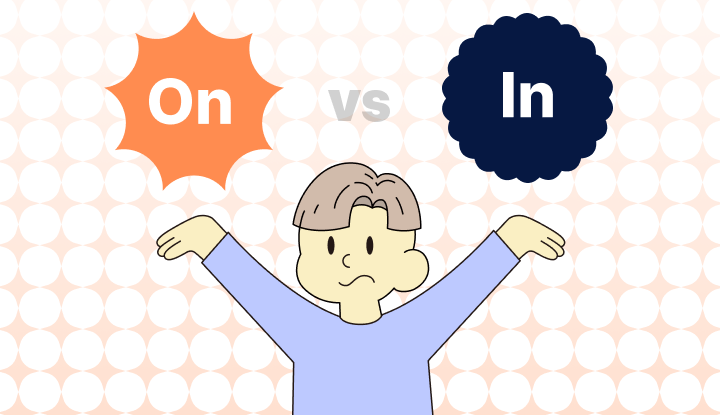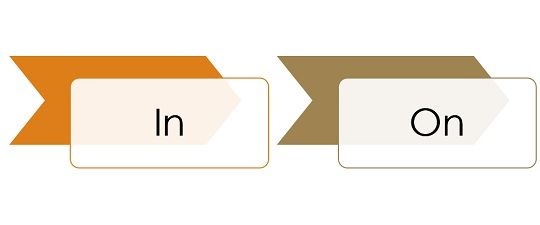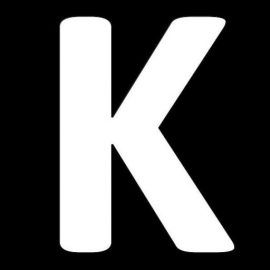Onとinは、英語で実際に最も頻繫に使われる前置詞です。しかし、非ネイティブの人には、いつどんな前置詞を使えばいいかよく迷うことになります。
もし今、電車の中にいるとしたら、「in the train」でしょうか。それとも「on the train」でしょうか?
Inは、ある空間や物体の中、もしくは囲まれた空間を示す場合に使います。Onは、何かの表面の上を示す場合に使用します。
以下は、時間の概念の上で、onとinを使った例文です。
- On: specific dates, days of the week, holidays
- In: month, season, quarter of the year, year, decades, centuries, school semester

Examples for "on"
- Specific date
The inauguration was on January 20, 2021.
- Day of the week
Jim did his presentation on Tuesday.
- Holiday
People light fireworks on Independence Day.
Examples for "in"
- Month
We are going on a trip to Spain in May.
- Season
In winter, the villager have to clear the snow from the streets.
- Quarter of the year
The company did well in Q4 last year.

場所を表現する概念では、次のように活用されます。
- On: street name
- In: city, state, country
以下は、2つの前置詞の違いを理解するための練習問題です。正解は、一番下から確認できます。
- The trash truck comes around in/on Thursdays.
- You shouldn’t wear leather in/on summer.
- In/on India, most people know multiple languages.
- The project will be due in/on June.
- In/on April 18th, Paul Revere rode his horse in town.
- Experts are predicting that the economy will get better in/on the Second Quarter of 2022.
- Where will you be in/on New Year’s Day?
- My teacher lives in/on Cherrygrove Lane, which is only a few streets down.
- I am taking an introductory physics course in/on spring semester.
- The entrepreneur has another house in/on California.
交通手段(subway, train, plane)は、文脈によってinもしくはonのどちらかを使用することができます。一般的には、「on a subway/train/plane」と言いますが、実際に車の中にいる状況を強調したい場合に「in a subway/train/plane」と言うこともできます。次の例文をご覧ください。
I’m on a train to New York City.
I can’t hear you clearly because I’m in the subway.
ただし、上記の内容がonとinの使い方についてむしろ混乱させるなら、onを使った方が安全です。 次は、inまたはonが前に位置する単語です。
- In: building, park, school, room, bag, backpack, pocket, elevator, pool, valley
- On: table, chair, floor, stairs, wall, road, street, escalator, beach, cliff, mountain
以下に、多くの練習問題を用意しました。 正確に理解しているか確認してみてください。
- He placed the books in/on the lobby counter.
- Henry is in/on a plane to Italy right now.
- Can you put this in/on your purse?
- Rose took a seat in/on the chair next to the door.
- The group of tourists went in/on the cafe to buy drinks.
- Her five-year-old son drew in/on the wall with his crayons.
- The students had a bonfire in/on the beach to celebrate their graduation.
- A fly just landed in/on that freshly washed plate.
- Jennifer put her dirty clothes in/on the laundry basket.
- There was a deer in/on the road on our way to the camping site.

もし、まだinとonの使い方が紛らわしい場合は、「Engram」で確認してみてください。 AI技術を活用して、英作文を迅速かつ正確に矯正してくれます。
無料英文チェッカー / 英語校正 - Engram
Engramの無料英文チェッカーと英文校正ツールを使用して、翻訳機の物足りない結果を校正・添削してみましょう。 文法、正書法の誤りとあいまいな英語表現をAIが自然に校正します。

正解
- on
- in
- in
- in
- on
- in
- on
- on
- in
- in
- on
- on
- in
- on
- in
- on
- on
- on
- in
- on
参考資料:
On vs. In
You use the preposition in when you are inside a space or object, and you use the preposition on when you are on top ofor directly above a space or object.

Difference Between In and On (with Comparison Chart) - Key Differences
The difference between in and on is that we use the word ‘in’ when we talk about a situation in which something that is enclosed by something else. On the other hand, ‘on’ is used to talk about the surface, or when the object is placed above or outside something else.















